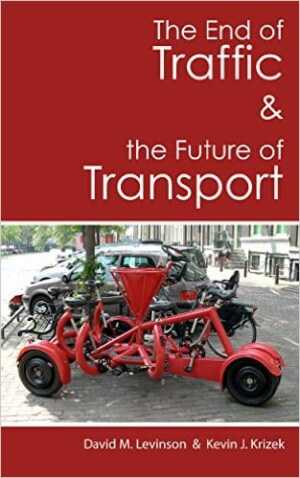The End of Traffic and the Future of Transport
David M. Levinson and Kevin J. Krizek
Kindle Editions
440 Terry Avenue N., Seattle, WA 98109; www.amazon.com/kindle-ebooks/.
361 pages. Ebook, $8.99.
One of the constants in transportation is traffic. It always increases—sometimes quickly, sometimes slowly—challenging engineers to find ways to regularly expand roads. The End of Traffic and the Future of Transport brings a contrary, and possibly threatening, alternative to conventional practice.
The authors—a transportation engineer and a planner—show that per-capita driving peaked in the 1990s, and while travel continued to grow because of population growth, the total number of miles traveled peaked in the 2000s. But why?
What killed traffic is not really a one thing, but rather death by a thousand cuts, according to professors Levinson and Krizek. Some of the factors include the following: cities, whose residents drive less than other people, are more pleasant nowadays; the nature of work is changing; online shopping is increasing; young drivers are less likely to get driver licenses; alternative transportation modes are increasingly used; and virtual connectivity is expanding.
The book depicts a transport context in most communities where new opportunities are created by the collision of slow-, medium-, and fast-moving technologies. Fast-moving technologies include computers and communication technologies, especially adopted by younger travelers. With an average life span of 11 years, cars would represent medium-moving technologies. The road network itself is the slowest moving of all, having been in place for years and unlikely to change much in the future. Changes likely to have a near-term impact include a range of emerging technologies, such as autonomous vehicles, electric vehicles, transit improvements, and better networking of car and cab sharing, referred to as mobility as a service (MAAS).
What about the impacts on land use and the corresponding feedback to vehicle travel? The book examines dramatic changes in working and shopping, both of which are expected to be dramatically influenced by technology. Recent data show that people are commuting less and shopping less, with comparable impacts on driving. Such changes are expected to continue and evolve, with, for example, social trips increasingly replaced by virtual connectivity so that one can “hang out” with a range of family and friends without leaving the comfort of one’s own home.
The authors identify two conflicting travel trends. The “up” trend suggests that there will be greater valuation for cities as people are willing to trade extensive commutes for being nearby. In contrast, there will be “out” pressures as well, since the increased speeds and reduced costs of driving, combined with the possibility of a vehicle that does the driving, will make it possibly comfortable to live much farther from job centers.
In The End of Traffic, parking is described as “America’s next greatest resource.” Although this one idea is not developed further, the vast amounts of excess space devoted to parking—especially in built-up areas—will offer great redevelopment opportunities.
In light of generally declining traffic, what about the road network itself? Levinson and Krizek take on the basics of transportation engineering, normally the closely guarded domain of highway and traffic engineers, illustrating the importance of using existing road space more efficiently. The book points out that most roads are underused most of the time, and most pavement is underused even in peak. This supports the urgency of adjustments to vehicle and lane widths, vehicle weights, and traffic signs and signals, extending the “complete streets” movement to incorporate a very different mix of travelers. The book touts the promise of better communications technology focused on signalized intersections to “eliminate almost all unstopped delay.”
As a final postscript demonstrating the commitment the authors have to transforming transportation, they proclaim the eventual extinction of the traditional transportation engineer—their primary constituency as teachers.
Robert T. Dunphy is a ULI emeritus fellow, an adjunct professor at Georgetown University, and a transportation consultant.

